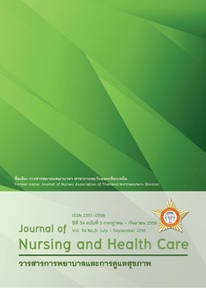ปัจจัยเสี่ยงและพฤติกรรมการดูแลตนเองของผู้ป่วยโรคความดันโลหิตสูงในชนบท สปป. ลาว Risk Factors and Self-Care Activities of Patients with Hypertension in Rural Area of Lao PDR
คำสำคัญ:
ปัจจัยเสี่ยง พฤติกรรมการดูแลตนเอง โรคความดันโลหิตสูง Risk factors, self- care behavior, hypertensionบทคัดย่อ
บทคัดย่อ
การวิจัยเชิงพรรณนานี้มีวัตถุประสงค์เพื่อศึกษาปัจจัยเสี่ยง พฤติกรรมการดูแลตนเอง และความสัมพันธ์ระหว่างปัจจัย
เสี่ยงกับระดับความดันโลหิตของผู้ป่วยโรคความดันโลหิตสูงในโรงพยาบาลเมืองนาทรายทอง นครหลวงเวียงจันทน์ สปป.ลาว โดยผู้วิจัยใช้แบบสัมภาษณ์ผู้ป่วยโรคความดันโลหิตสูง จำนวน 209 คน วิเคราะห์ข้อมูลเชิงปริมาณโดยใช้สถิติเชิงพรรณนา และทดสอบค่าความสัมพันธ์โดยใช้ไควสแควร์ผลการศึกษา พบว่า ผู้ป่วยโรคความดันโลหิตสูงส่วนมากอยู่ในช่วงอายุ 50 – 59 ปี ร้อยละ 32.5 เป็นเพศหญิง ร้อยละ55.0 มีโรคร่วม ร้อยละ 55.0 โรคร่วมที่มากที่สุดคือเบาหวาน ร้อยละ 44.3 ญาติสายตรงป่วยเป็นโรคเรื้อรัง ร้อยละ 46.4ดัชนีมวลกายอยู่ในช่วง 25 – 29.9 ร้อยละ 35.9 ค่าความดันโลหิตอยู่ระหว่าง 140 - 159/90 – 99 mmHg ร้อยละ 46.9 มีค่าเฉลี่ยคะแนนความรู้การดูแลตนเองเท่ากับ 10.56 ส่วนเบี่ยงเบนมาตรฐานเท่ากับ 2.17 ความรู้อยู่ในระดับปานกลาง ร้อยละ 43.5 มีค่าเฉลี่ยคะแนนทัศนคติต่อการดูแลตนเอง 34.51 ส่วนเบี่ยงเบนมาตรฐาน 4.68 ทัศนคติอยู่ในระดับสูง ร้อยละ51.7 มีค่าเฉลี่ยพฤติกรรมการดูแลตนเอง 32.78 ส่วนเบี่ยงเบนมาตรฐาน 4.15 พฤติกรรมการดูแลตนเองอยู่ในระดับปานกลาง ร้อยละ 71.8 ความสัมพันธ์ระหว่างปัจจัยเสี่ยงต่อการควบคุมความดันโลหิตมี 6 ปัจจัย ได้แก่ อายุ χ2 = 13.7 (P <0.001) ระดับการศึกษา χ2 =10.71 (P = 0.03) รายได้ต่อเดือน χ2 =18.59 (P < 0.001) ระยะเวลาป่วยเป็นโรคความดันโลหิตสูง χ2 =11.9; (P = 0.03) ภาวะโรคร่วม χ2 = 8.73 (P < 0.001) และพฤติกรรมการดูแลตนเอง χ2 = 6.30 (P = 0.03)ส่วนความรู้และทัศนคติไม่มีความสัมพันธ์ต่อระดับความดันโลหิต χ2 = 4.40 (P = 0.11) และ χ2 = 5.40 (P = 0.06)
Abstract
This descriptive study aimed to investigate association between risk factors and self-care activities with blood pressure level among patients with hypertension at Muang Nasaitong Hospital, Vientiane, Lao PDR. Questionnaires were administered to 209 patients with hypertension in the rural area. Descriptive statistics was used for descriptive data analysis and Chi-square test was used for analysis of association between risk factors, self-care
activities, and blood pressure level. Findings showed that most of the patients with hypertension were in the age group 50-59 years old (32.5%). Fifty-five percentages of them were female with the same number who had co-morbidity. The most common
co-morbidity was diabetes (44.3%). Additionally, 46.4% of the participants had family relative(s) with chronic conditions. Most of the patients with hypertension had the body mass index (BMI) ranged between 25–29.9 (35.9%), systolic blood pressure (SBP) level ranged between 140-159 mmHg, and diastolic blood pressure (DBP) level ranged between 90-99 mmHg (46.9%). The mean self-care knowledge was 10.56 (SD = 2.17) with approximately 44% of participants had the moderate knowledge level. The mean attitude towards self-care was 34.51 (SD = 4.68) with approximately 52% of participants had the high attitude towards self-care. The mean self-care behavior was 32.78 (SD = 4.15) with approximately 72% of participants had the moderate self-care behavior level. There were
6 personal risk factors found to be associated with blood pressure control including age (χ2 = 13.7, P < 0.001),education (χ2 = 10.71, P = 0.03), monthly income (χ2 = 18.59, P < 0.001), duration of hypertension (χ2 = 11.9,P = 0.03), co-morbidity (χ2= 8.73, P < 0.001), and self-care behavior (χ2 = 6.30, P = 0.03). In contrast, knowledge andattitude had no association with hypertension control (χ2 = 4.40, P = 0.11), and χ2 = 5.40, P = 0.06, respectively)



